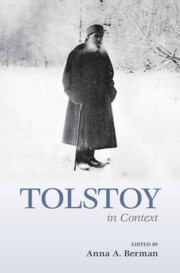Book contents
- Tolstoy in Context
- Tolstoy in Context
- Copyright page
- Contents
- Figures
- Notes on Contributors
- Preface
- Acknowledgments
- Note on Citations, Translations, and Transliterations
- Chronology
- Part I The Man
- Part II Russian Social and Political Contexts
- Part III Literature, the Arts, and Intellectual Life
- Chapter 16 Tolstoy’s Oeuvre
- Chapter 17 Peasant Schools and Education
- Chapter 18 Russian Philosophy
- Chapter 19 The Russian Literary Scene
- Chapter 20 European Literature
- Chapter 21 European Philosophy
- Chapter 22 Theater
- Chapter 23 Music
- Chapter 24 The Visual Arts
- Part IV Science and Technology
- Part V Beyond Russia
- Part VI Tolstoy’s Afterlife
- Suggested Further Reading
- Index
Chapter 24 - The Visual Arts
from Part III - Literature, the Arts, and Intellectual Life
Published online by Cambridge University Press: 05 January 2023
- Tolstoy in Context
- Tolstoy in Context
- Copyright page
- Contents
- Figures
- Notes on Contributors
- Preface
- Acknowledgments
- Note on Citations, Translations, and Transliterations
- Chronology
- Part I The Man
- Part II Russian Social and Political Contexts
- Part III Literature, the Arts, and Intellectual Life
- Chapter 16 Tolstoy’s Oeuvre
- Chapter 17 Peasant Schools and Education
- Chapter 18 Russian Philosophy
- Chapter 19 The Russian Literary Scene
- Chapter 20 European Literature
- Chapter 21 European Philosophy
- Chapter 22 Theater
- Chapter 23 Music
- Chapter 24 The Visual Arts
- Part IV Science and Technology
- Part V Beyond Russia
- Part VI Tolstoy’s Afterlife
- Suggested Further Reading
- Index
Summary
This chapter examines Leo Tolstoy’s views on the visual arts and aesthetic debates of his time as expressed in his seminal publication What Is Art? (1897). It contextualizes the writer’s ideas about painting and representation within the principal controversies and prevalent issues of the Russian art world of 1870–90, and especially in relation to the theories and praxis of the Wanderers or Peredvizhniki. More specifically, it focuses on Tolstoy’s intellectual exchanges with and support for several of the most prominent and important artists of the day, such as Ivan Kramskoi, Ilya Repin, and Nikolai Ge, highlighting the discursive intersections between his writing and their paintings, and the broader politics of intermediality in nineteenth-century Russian realism.
- Type
- Chapter
- Information
- Tolstoy in Context , pp. 194 - 204Publisher: Cambridge University PressPrint publication year: 2022

